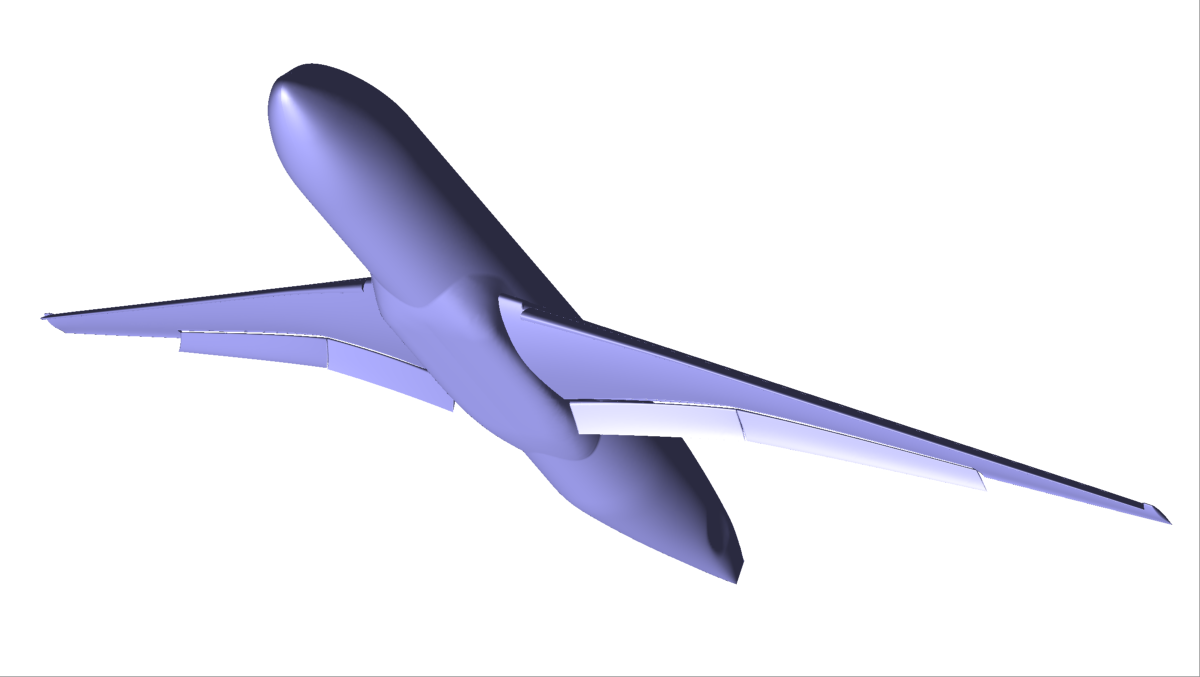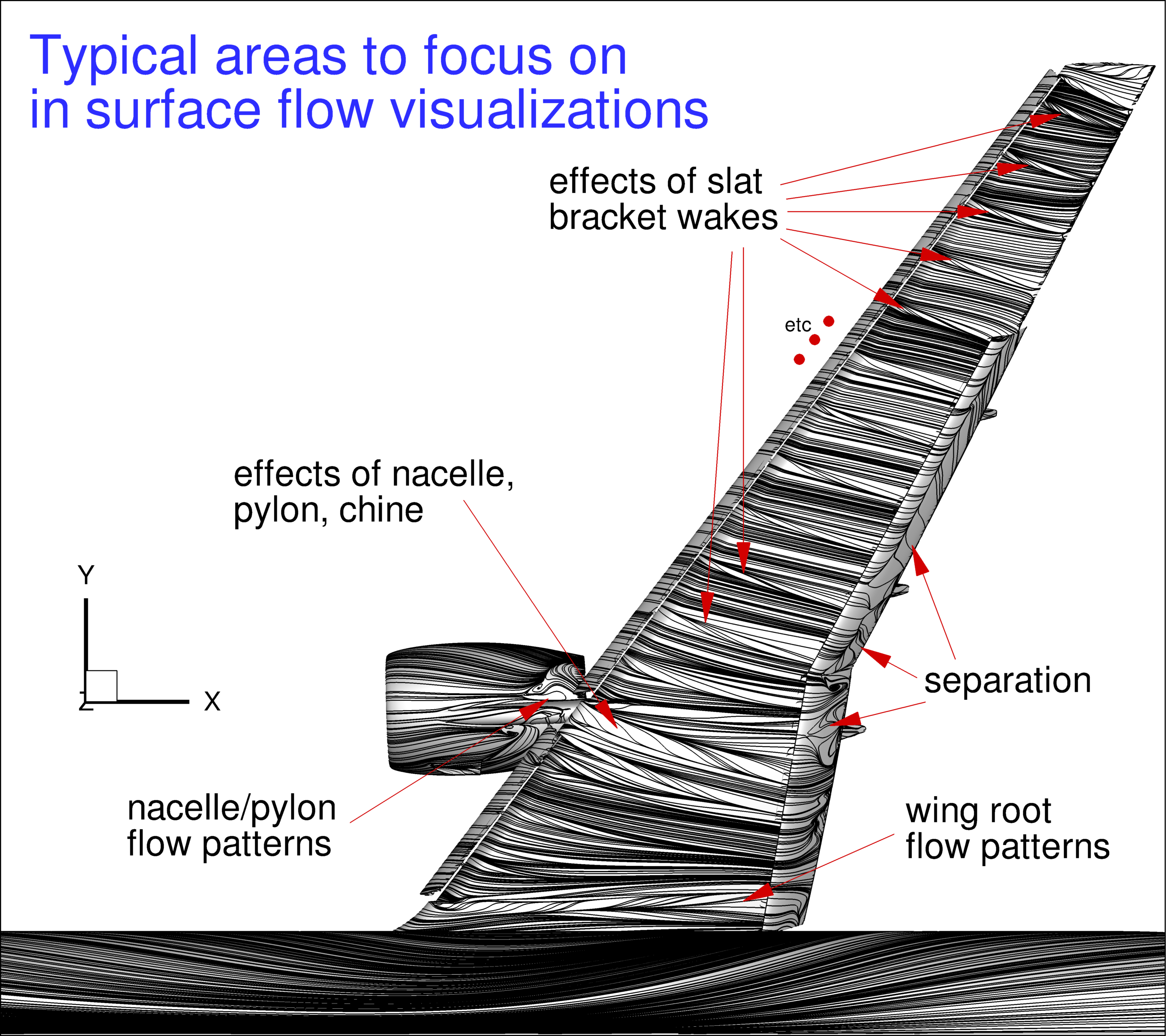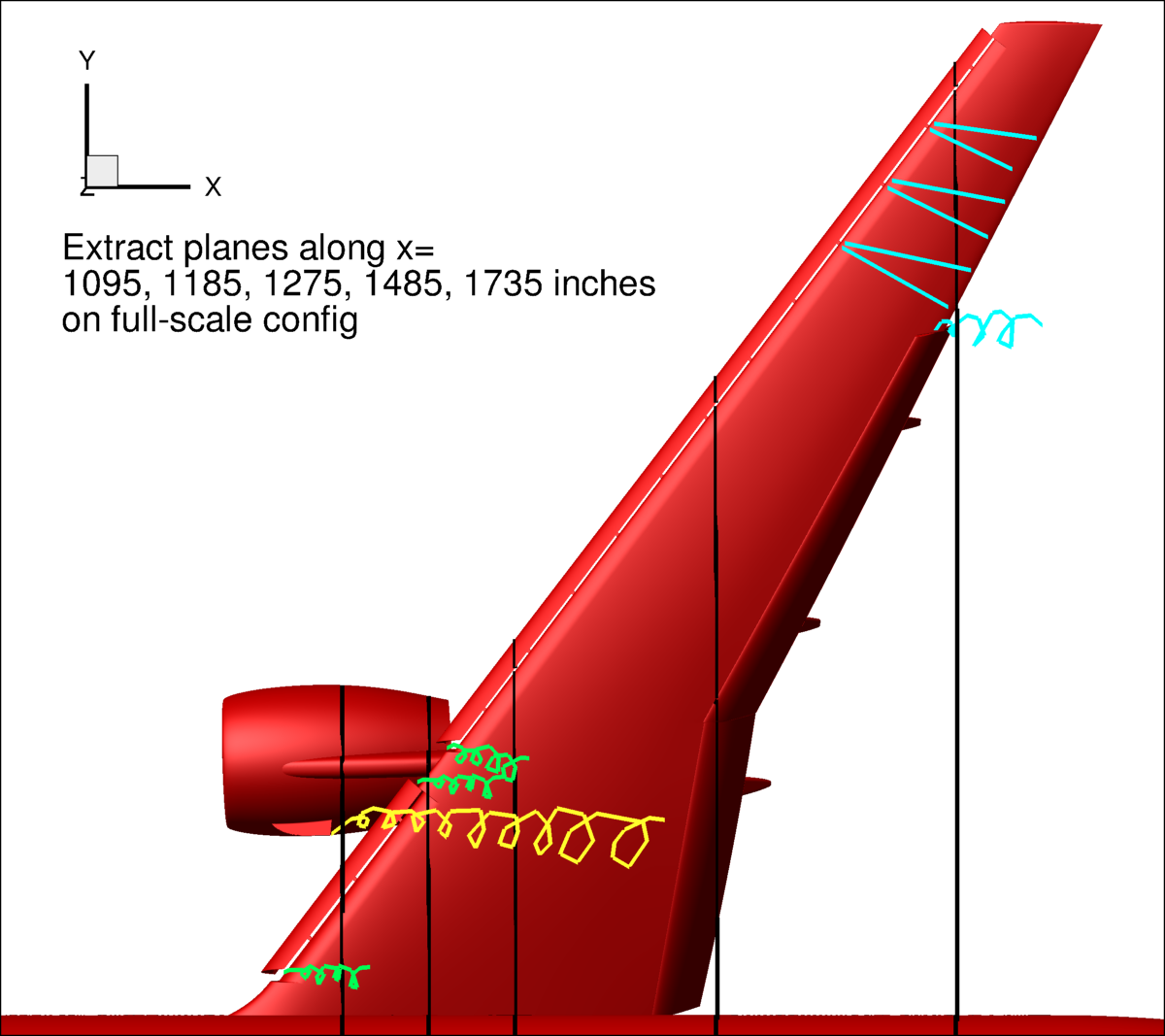
DATA SUBMITTAL FORMS & POSTPROCESSING INFO
4th
AIAA CFD High Lift Prediction Workshop
and
3rd
Geometry and Mesh Generation Workshop
Data Submittal Forms
The Tecplot-readable Data Submittal Forms are provided in the following tarred gzipped directory:
Changes from previous versions: README.changes_from_previous_versions
DETAILED INSTRUCTIONS FOR PREPARING DATA SUBMITTAL FORMS
- Data should be submitted in a logically-named directory that includes your PID, your last name, code, model, and any
other important identifying information. Download the above tarred gzipped directory, unzip and untar it, then rename it.
If you are submitting only one set of data, then the directory name should end with BESTPRACTICE. For example,
N. Ashton might have the sole directory name "L-001_Ashton_Openfoam_SA_101grids_BESTPRACTICE", where L-001 is N. Ashton's assigned PID.
- If you are part of a team, then you should choose just one member's PID that your team will use for everything.
- If you are submitting multiple sets of data (for example, different grid types, different turbulence models, different
methodologies, etc.) then EACH DISTINCT SUBMISSION SHOULD HAVE ITS OWN DIRECTORY OF DATA, and each of your datasets
should have an appended number ".1", ".2", ".3", etc. added to the PID in order to distinguish between them.
For example, if your PID is A-001, you would use A-001.1, A-001.2, A-001.3,
etc. for multiple distinct types of submission variants.
Include the phrase "BESTPRACTICE" at the end of any directory that you consider to be a "best practice" result.
In general, all of your "BESTPRACTICE" results should probably be on what you consider your "best" grid. Note that Cases 1b and 3 include
grid convergence studies and therefore require results on additional grid levels, but all other Cases in a given directory only use
one grid level.
Directories without "BESTPRACTICE" in the name can be used for exploratory or demonstrative results that you feel are important to submit
(different grid families, coarser grids, grids you weren't as happy with, different methods, different models, etc.)
For example, T. Michal might want to submit 5 directories of distinctly different
results, one of which he considers to be his "best practice" set:
- A-001.1_Michal_BCFD_SA_limiter_2Dgrids_BESTPRACTICE
- A-001.2_Michal_BCFD_SA_limiter_2Cgrids
- A-001.3_Michal_BCFD_SA_limiter_2Bgrids
- A-001.4_Michal_BCFD_SST_timeaccurate_2Dgrids
- A-001.5_Michal_BCFD_SA_nolimiter_2Bgrids
The corresponding PID (A-001.1, A-001.2, A-001.3, etc.) should be used within each respective directory.
- In all filenames within the directory, replace XXX with your assigned PID, e.g., G-011, R-048, A-002, H-013,
L-025, W-047, W-047.1, W-047.2. For example, XXX_case2b_CLmax_WT_FM.dat should be changed to R-048_case2b_CLmax_WT_FM.dat
for participant R-048, and to W-047.2_case2b_CLmax_WT_FM.dat
for the 2nd dataset from participant W-047.
- Inside each data submittal file, replace ALL occurrences of XXX with your assigned PID.
Include the appended number if you are using one. Other than the XXX, please do not change the names of any zones inside the files.
- Some data files include DATASETAUXDATA lines. Please fill out as appropriate.
- Please include your surface streamline pictures under the subdirectory XXX_SurfaceFlowVisualizations. The
preference is that you submit png format, if possible. Please use the recommended "CFD views", and
name them
- XXX_aoaYYY_stream_cfdview_01.png
- XXX_aoaYYY_stream_cfdview_02.png
- XXX_aoaYYY_stream_cfdview_03.png
- etc.
corresponding to the views shown on https://hiliftpw.larc.nasa.gov/Workshop4/DataForm.html. Change the XXX in
the filename to your PID and the YYY in the filename to the angle of attack; for example:
"H-013_aoa7.05_stream_cfdview_01.png". If providing other non-CFD views (for example, to try to match wind tunnel
oil flow photos), name them so that it is clear what they are, and include details in the README.txt file
located under XXX_SurfaceFlowVisualizations.
Add additional descriptive information to
the name if needed (e.g., "F3734" if providing figures for flap angle 37/34 or "MeshX" if providing figures
for different meshes in the family).
- Please include your surface Cf contour pictures in the same subdirectory
(XXX_SurfaceFlowVisualizations). Please use the recommended "CFD views" for Cf, and
name them
- XXX_aoaYYY_cf_cfdview_01.png
- XXX_aoaYYY_cf_cfdview_02.png
- XXX_aoaYYY_cf_cfdview_03.png
- etc.
- Please include your off-body vorticity plots under the subdirectory XXX_OffBodyVorticity.
Please use the recommended "CFD views", and name them
- XXX_aoaYYY_vort_cfdview_11.png
- XXX_aoaYYY_vort_cfdview_12.png
- XXX_aoaYYY_vort_cfdview_13.png
- etc.
- XXX_aoaYYY_vort_cfdview_11+grid.png
- XXX_aoaYYY_vort_cfdview_12+grid.png
- XXX_aoaYYY_vort_cfdview_13+grid.png
- etc.
corresponding to the views shown on https://hiliftpw.larc.nasa.gov/Workshop4/DataForm.html. Change the XXX in
the filename to your PID and the YYY in the filename to the angle of attack; for example:
"H-013_aoa7.05_vort_cfdview_11.png".
Add additional descriptive information to
the name if needed (e.g., "F3734" if providing figures for flap angle 37/34 or "MeshX" if providing figures
for different meshes in the family).
- Be sure to fill out the file XXX_participant_info.dat located within each directory. This identifies you and
your method, among other things, for that directory.
- If you are a member of more than one TFG but have only one set of data to submit, then select the PID from one
of your TFGs, and use only that. Let us know in the XXX_participant_info.dat file that the data is also associated
with another TFG.
- Each directory should include ALL the test case data files (for Cases 1a, 1b, 2a, 2b, and 3) that
you choose to participate in.
Before tarring or zipping up your directory, remove any files that you are not using. For example, if you
are not providing any data for Case 2b, then remove all files "XXX_case2b_CLmax*.dat" from the directory.
- If you need to update your results prior to the deadline, then re-send the entire directory again.
Assume that we will throw away your old directory and start reading everything from the new one.
Edit the file XXX_participant_info.dat and provide: (1) the
date of the latest submission and (2) a list of things changed, added, or subtracted since the last
submission.
- ADDITIONAL CLARIFICATION REGARDING A TYPICAL SUBMISSION:
A typical submission will consist of one directory of data, labeled
with the naming convention BESTPRACTICE.
Submitting results for only a subset of the cases is allowed.
Partial results (e.g., results for only 4 AoAs out of the 7 requested for Case 2a or b) are also allowed...
simply fill in what you have.
All results in the directory should use the same methodology (same turbulence model, numerical method, etc.).
Nominal results from Cases 1a and 2a should be on the same grid, considered your "best." Results from Case 1b
should include results from this same grid plus other coarser levels of the same family. If Case 2b is included, it
should use an in-tunnel grid similar to that used for Case 2a, but rotated appropriately for each
angle of attack. Case 3 results in the directory should correspond to the same turbulence model and
numerical method used for the other cases in the directory.
Any png files of streamlines and Cf should be in subdirectory XXX_SurfaceFlowVisualizations, and
png files of off-body vorticity should be in subdirectory XXX_OffBodyVorticity.
The priority for the figures is that you provide results on your "best" grid, used for Cases 1a, 2a, and 2b;
providing figures from coarser mesh levels of the family is optional.
Data that does not clearly fit in one of the existing forms (e.g., case 2a or b data for
other grid levels) should optimally be put in separate data directories without BESTPRACTICE
designation (one for each grid level).
If there is no good option, then new data files with clear naming conventions are also allowed.
- Submit your tarred or zipped directory to Li Wang.
If the file is too large to email, then contact
Li Wang to arrange for file transfer in another way.
Please do not re-organize the data structure provided in
XXX_Lastname_Code_Model_v9.tar.gz. Your directory of results should maintain the original look and organization.
Postprocessing: Mean Surface Pressures and Skin Friction Extraction
The surface data are to be extracted in the (approximate) planes containing the pressure taps.
Note that when deployed, the pressure tap rows are not aligned on all 3 elements (they are aligned only when stowed). See the
figure below, showing the configuration with slat and flap elements deployed.
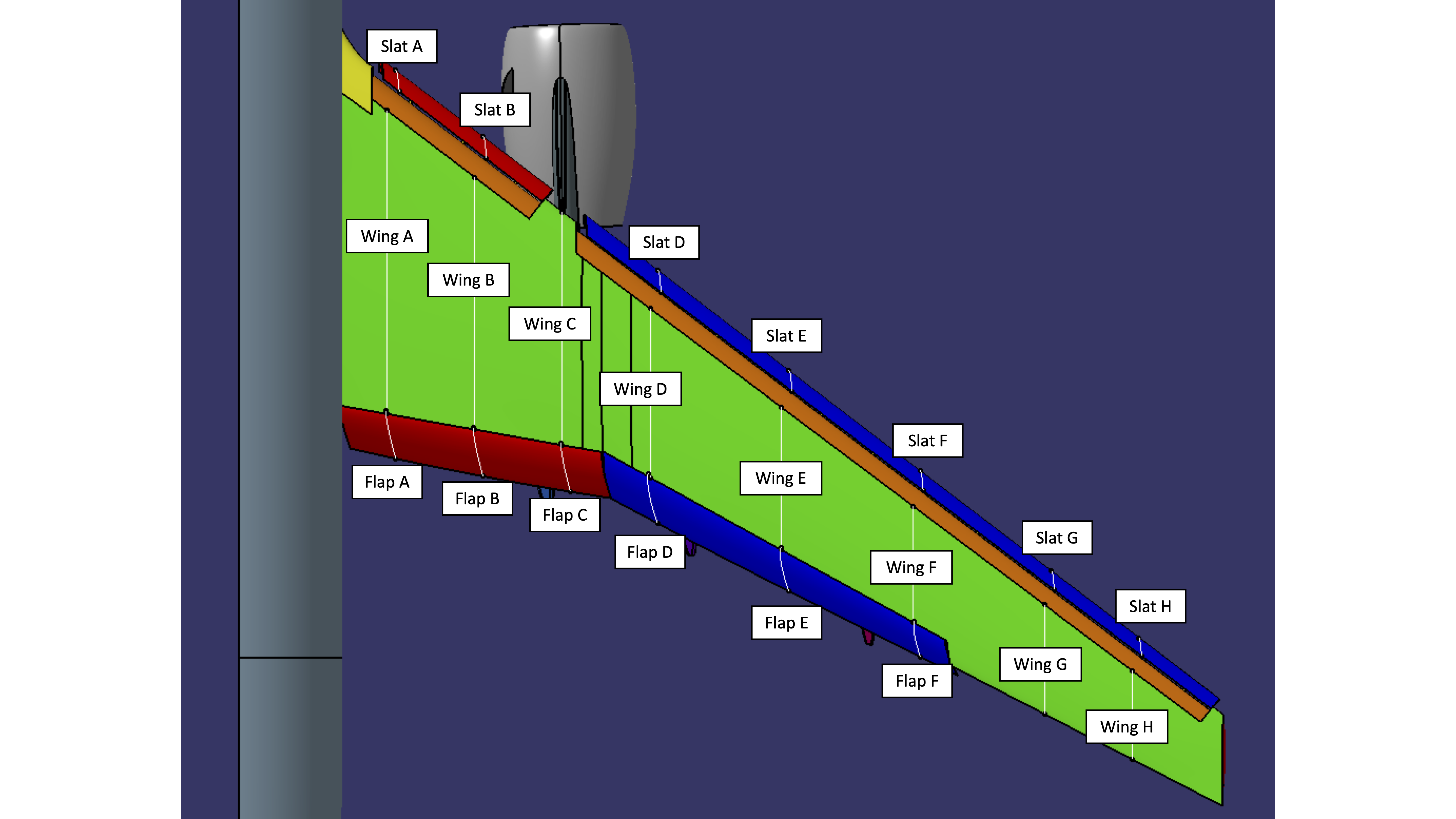
Note that the configuration is defined in the +Y plane, in full-scale inches. The following text file defines equations
(Ax + By + Cz = D) for the planar cuts that approximately intersect the
pressure taps for the 7 span stations on the main wing, slat, and flap when in deployed position:
CuttingPlane_CRM-HL_v1.txt.
For those participants with access to Tecplot360 EX, macro files are provided here that can be used to help extract data on the surface
of the full-scale configurations (inches) approximately along all of the
requested pressure tap planes (v3 was posted 3/31/2021; it removed the lines "TransientOperationMode = AllSolutionTimes" which
were problematic for some people):
Some editing of the macros may be required... see instructions inside the file.
Note that these macros define each cutting plane by specifying 3 sets of X,Y,Z coordinates that lie in the plane, as defined by the equations in
the above CuttingPlane_CRM-HL text file.
Also, be aware that the Tecplot extraction will include ANY active surface cut by a specified plane, even if unintended.
(For the purposes of the workshop, this is acceptable.)
Because the above macro extraction will include ANY active surface cut by a specified plane, even if unintended,
an alternative set of macros is provided below, if desired. These
macros separate out the slat, wing, and flap element extractions. They can be used
in the following way in Tecplot:
(1) Turn off all but the slat element(s) and use the slat_cutter macro to extract slices on the slat,
(2) Turn off all but the wing element(s) and use the wing_cutter macro to extract slices on the wing,
(3) Turn off all but the flap element(s) and use the flap_cutter macro to extract slices on the flap.
Note that the slat and wing cutters are identical on all three configurations, except the zone name is changed.
The macro files can be edited. For example, if you know for your grid that you want to
turn off zones 1 and 5 when extracting on a particular element, it can be done with:
$!ActiveFieldMaps -= [1]
$!ActiveFieldMaps -= [5]
Postprocessing: Velocity Profiles and Unsteady Surface Pressures at Specific Locations on the Wing
Velocity profiles and unsteady surface pressures are being requested at the same locations over the wing.
The locations are identified in the figure below. These correspond to locations where unsteady pressure measurements
may be made in future wind tunnel tests (on the model upper surface). For velocity, profiles should be
extracted along z at the given specific x and y locations (provide enough z-height to include at least all
the boundary layer and any upstream-element wakes... giving too much will not hurt).
The z-direction is with respect to the aircraft reference frame as given in the original CAD files; i.e., the location of
the lines of data along z should be identical regardless of the angle of attack.
For unsteady pressures (relevant only for time-accurate
simulations), data should be extracted on the wing upper surface.
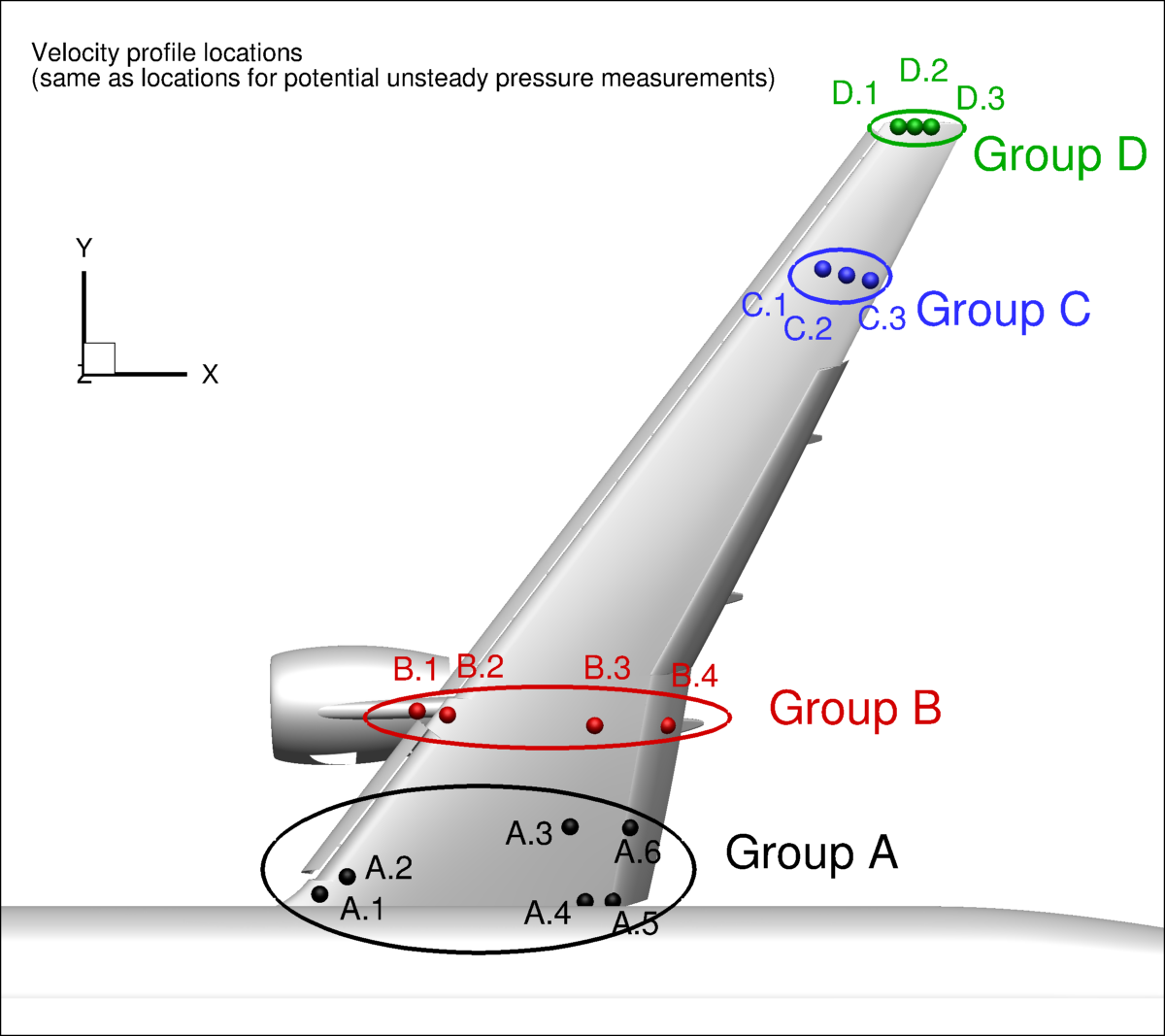
The locations are listed in the files:
kulites_locations_final_40_37.dat,
kulites_locations_final_37_34.dat,
kulites_locations_final_43_40.dat.
The only difference between the 3 files are the locations A.5, A.6, and B.4 (all located on the flap, which is rotated
differently for the 3 configurations).
These locations for velocity can also be used to extract other flowfield quantities of interest
(such as modeled eddy viscosity, shielding/blending
functions, etc.), although there currently are no official data submittal forms for it.
Participants are also welcome to extract data at other locations, or over broader regions, if desired (the more we can
learn about the flowfield from CFD, the better!)
Postprocessing: Surface Streamlines and Skin Friction Coefficient (Cf) Contours
A major set of desired inputs from the CFD are computed surface streamlines (particularly on the CRM-HL configuration's
upper surface), for comparison with surface oil
flow photos. This is particularly important for ascertaining the agreement/disagreement with
regions of separation and other flow features of interest from the experiment.
Below is an example surface streamline plot, showing typical areas of interest for HLPW-4.
There are many methods available for obtaining postprocessed surface streamline patterns; at this time, participants
are encouraged to make use of the best tools at their disposal.
Contours of surface skin friction coefficient are also very useful to plot (see second figure immediately below).
In both cases, if your method is unsteady, then mean streamlines and skin friction contours should be plotted.
In the second figure, the Tecplot color map is provided as
cfmap_tecplot.map. It is given by:
| LEVEL
|
R
|
G
|
B
|
| 0.00
|
0
|
0
|
0
|
| 0.25
|
0
|
191
|
255
|
| 0.50
|
127
|
255
|
0
|
| 0.75
|
255
|
0
|
64
|
| 1.00
|
255
|
255
|
255
|
and the recommended range (shown in the figure) is 0 to 0.015, step 0.001 (banded). In the Cf plot, the "lighting" has been turned off;
this reduces the 3-dimensional appearance of the objects, but it improves the interpretability of the colors.
If everyone removes lighting and follows the color scheme and range detailed here, then the resulting CFD
plots should be reasonably easy to compare directly with one another.
The Tecplot layout files for the above two pictures are provided here (minus the arrows and extra words):
XXX_aoa7p05_stream_cfdview_01.lay and
XXX_aoa7p05_cf_cfdview_01.lay.
However, note that these files are most likely NOT directly applicable to most participants' surface grid or surface data; therefore
they should be used for guidance only (also, different surface streamline seeding may yield better visualizations; this is
an example only).
For direct CFD comparisons with other CFD, some recommended views (including Tecplot nomenclature for orientation) are shown below,
where the configuration is in full-scale inches.
In Tecplot, the "use perspective" feature is not turned on for any views.
The CFD views 1-4 are the simplest, taken looking directly down on the configuration (psi=theta=alpha=0);
they should be relatively easy to approximately match, even if only trying to recreate the views using visual cues.
The best views for direct comparisons with wind tunnel oil flow photos are not known, and are currently up to each participant.
NOTE: Ten views are shown. Please provide as many as you are able. Priority views are 1 through 5.
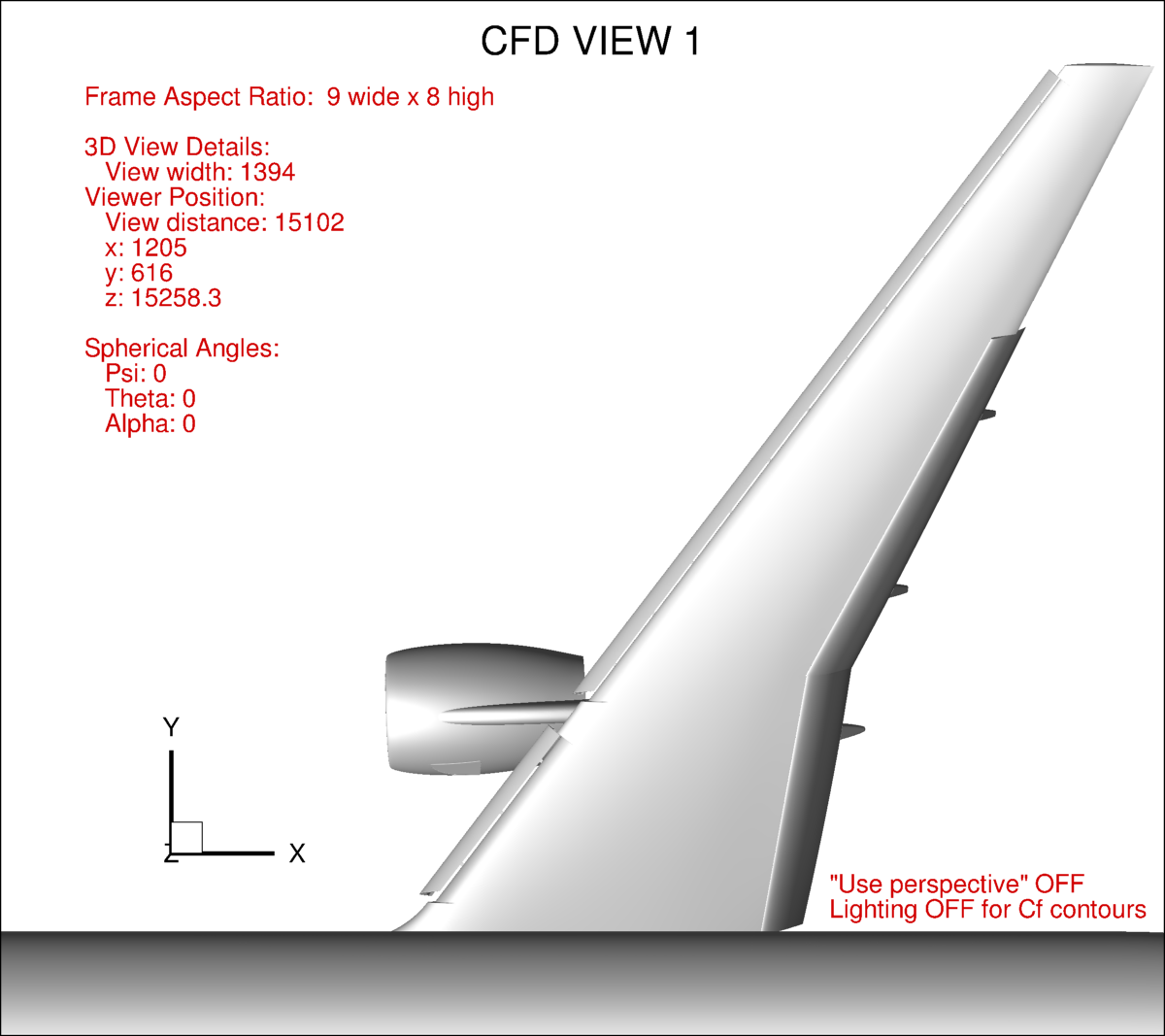
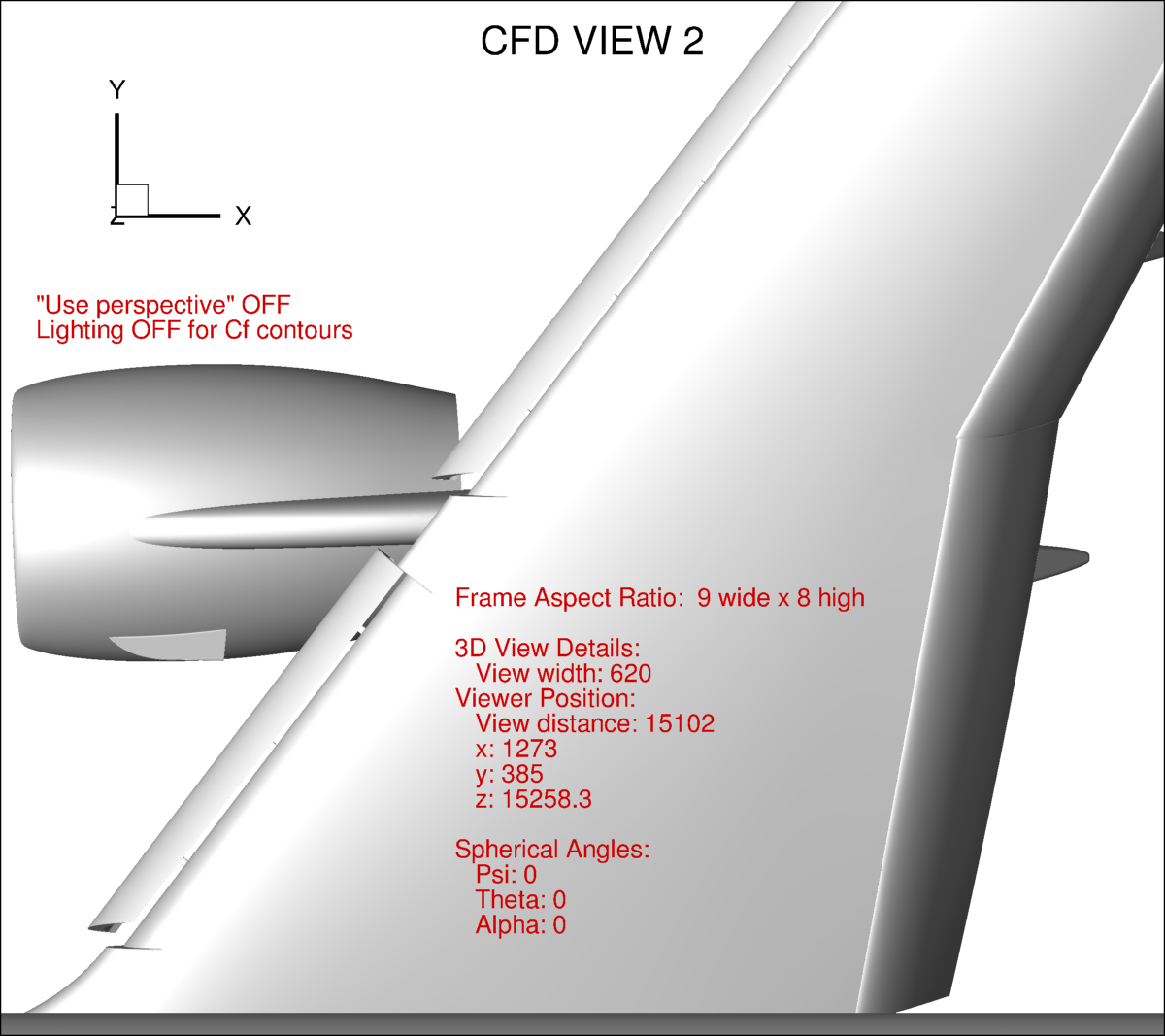
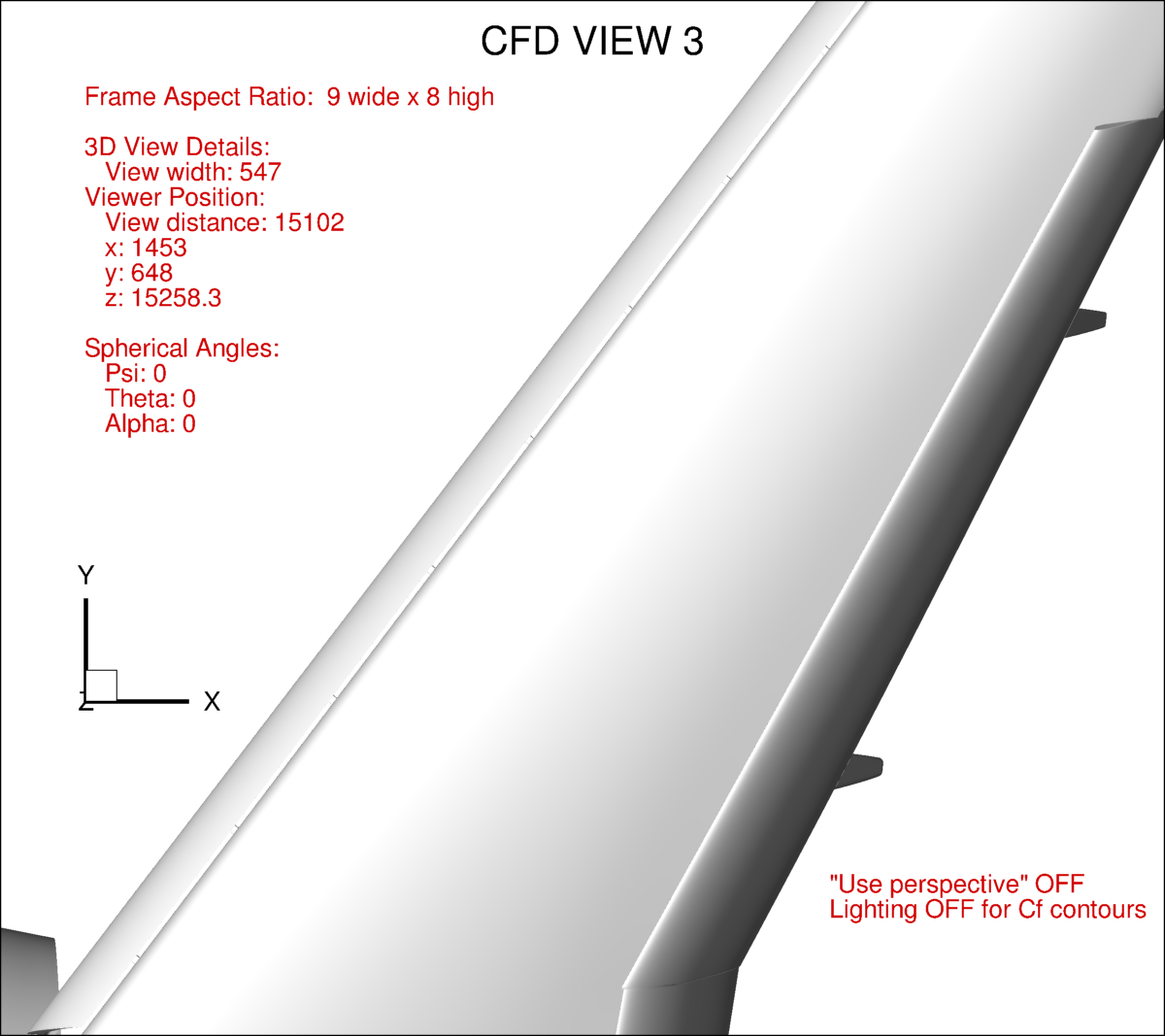

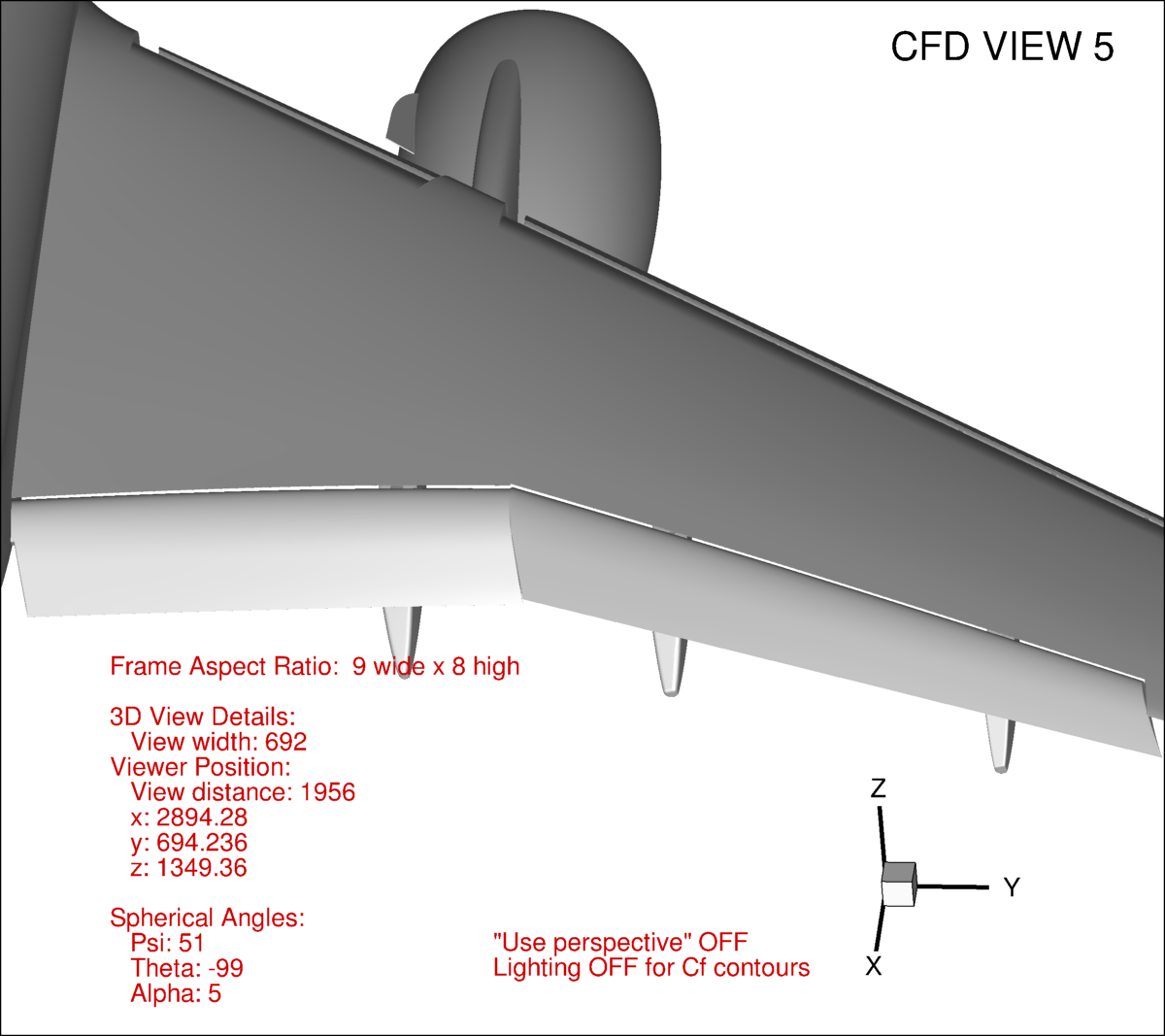
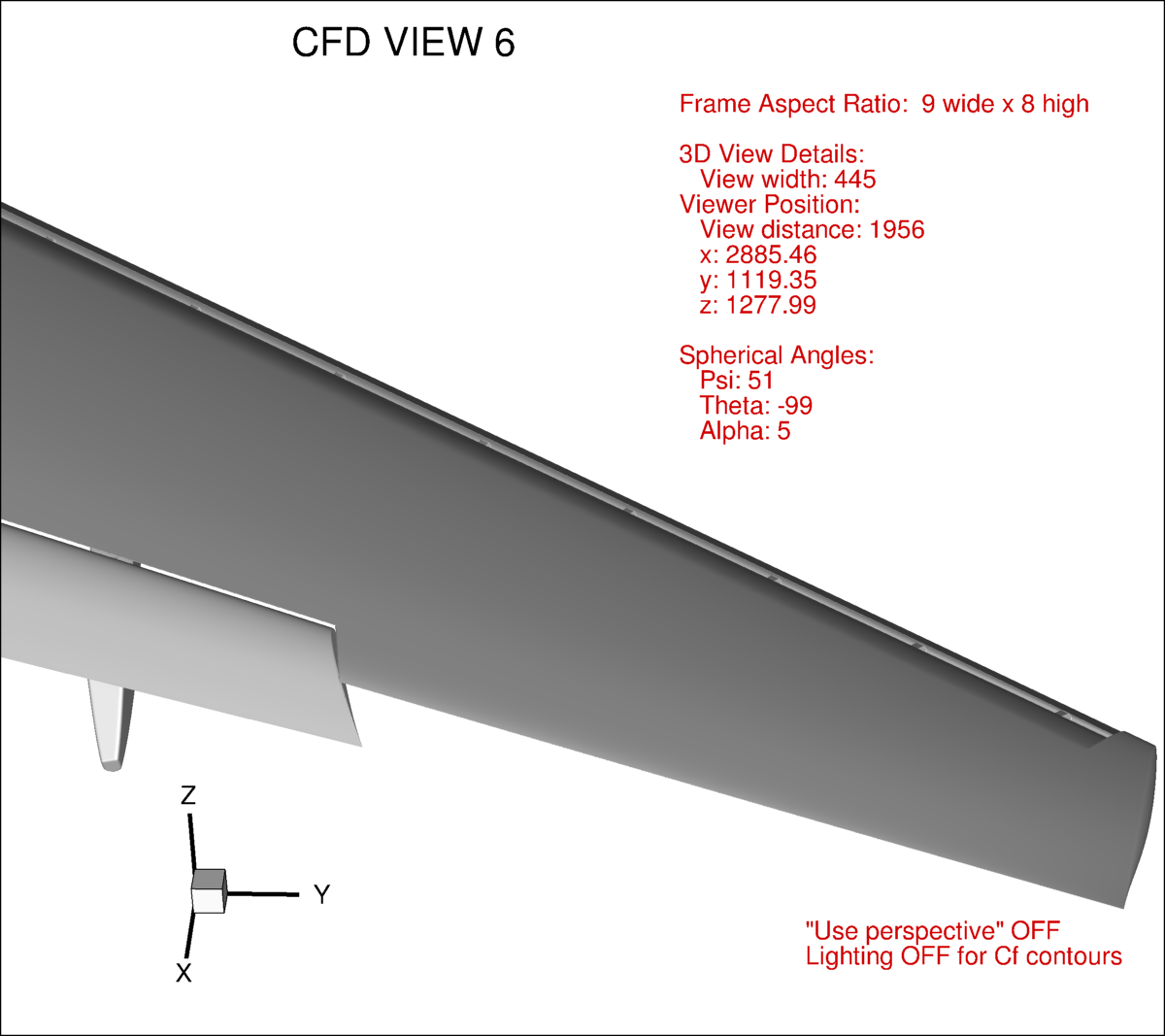
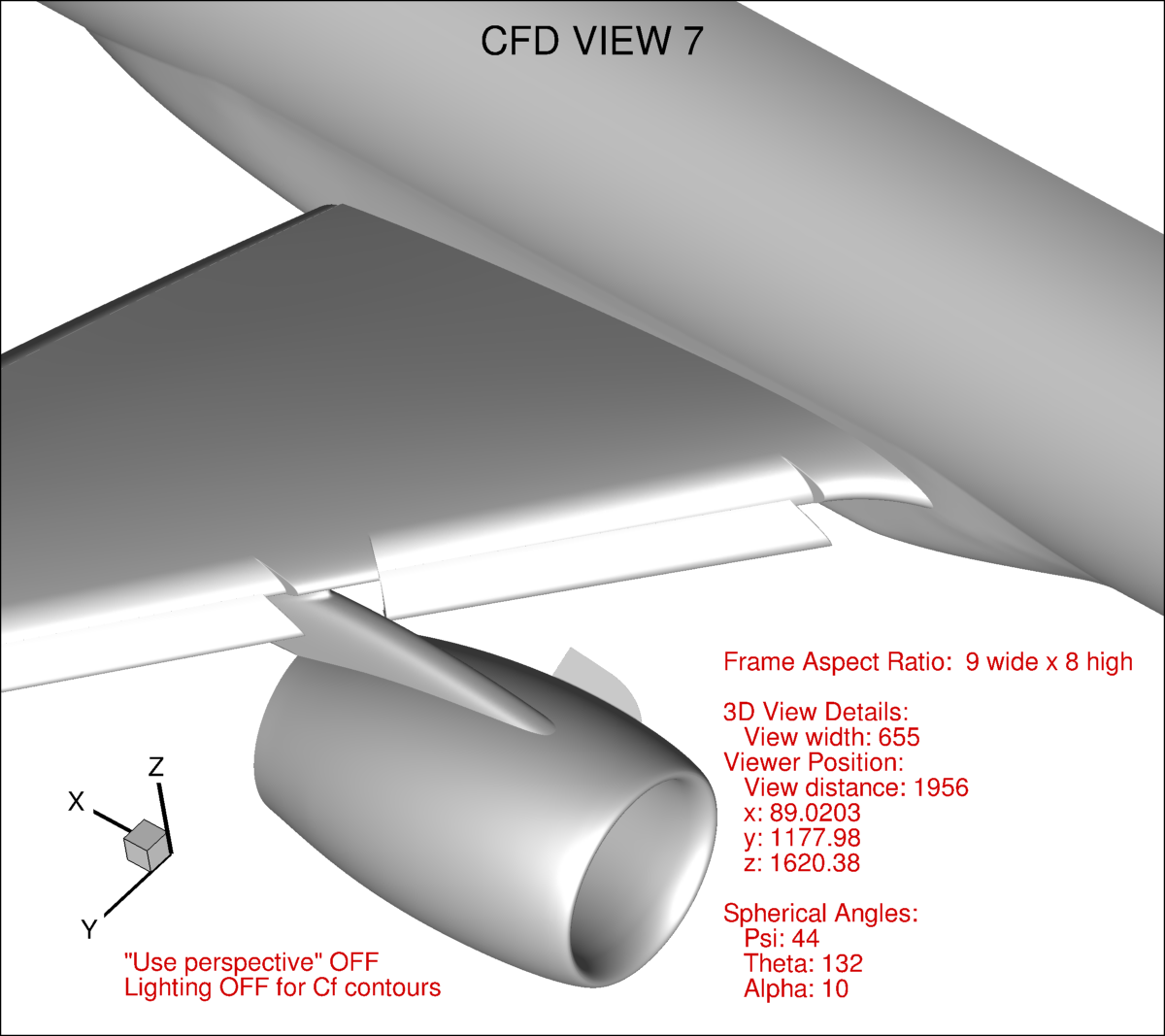


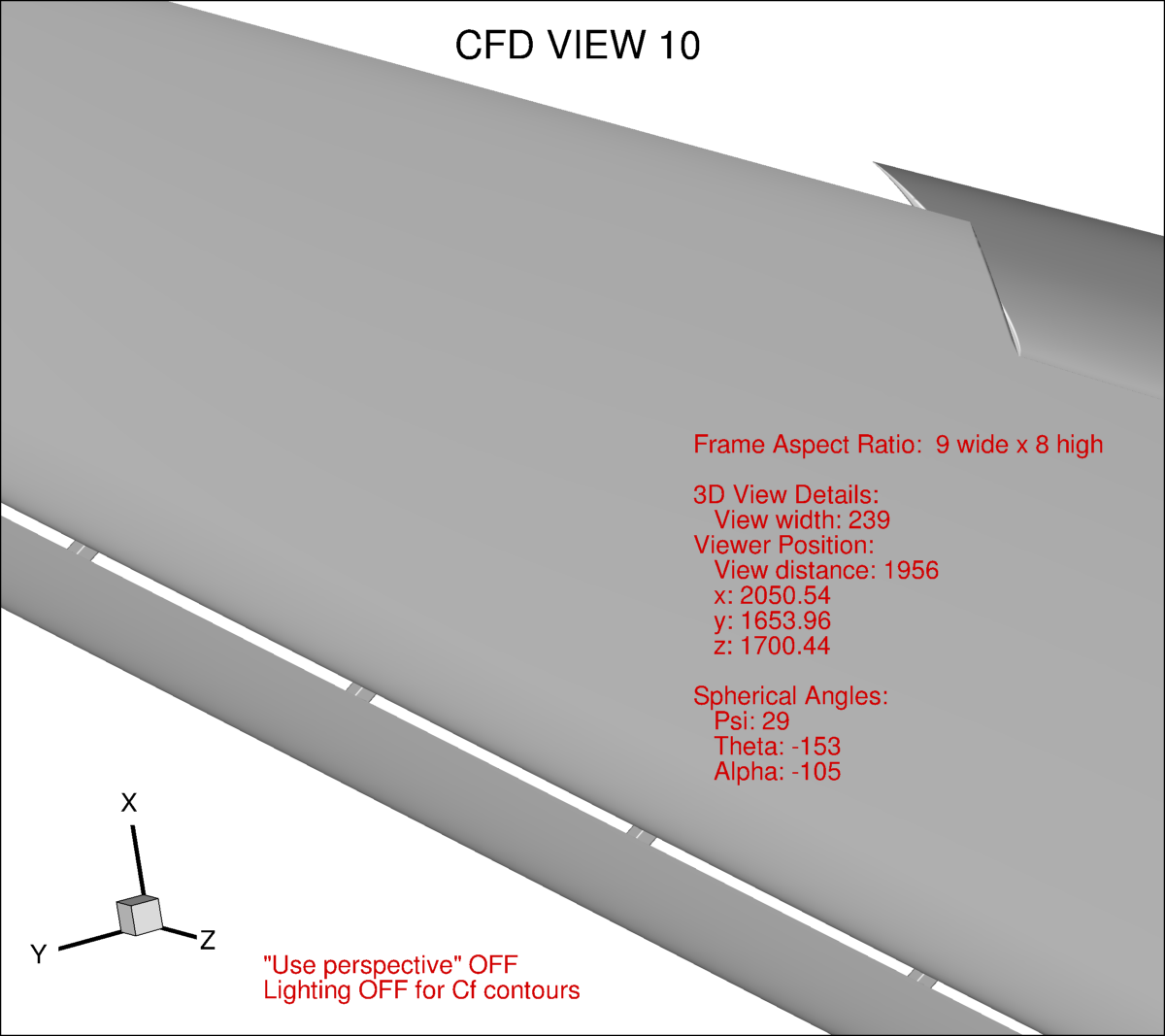
The Tecplot layout files for the above ten pictures are provided here:
XXX_cfdview_01.lay,
XXX_cfdview_02.lay,
XXX_cfdview_03.lay,
XXX_cfdview_04.lay,
XXX_cfdview_05.lay,
XXX_cfdview_06.lay,
XXX_cfdview_07.lay,
XXX_cfdview_08.lay,
XXX_cfdview_09.lay,
XXX_cfdview_10.lay.
However, note that these files are most likely NOT directly applicable to most participants' surface grid or surface data; therefore
they should be used for guidance only.
Postprocessing: Off-Body Vorticity Contours
Vortices shed from upstream elements play a major role in the CRM-HL flowfield. We are asking participants to
plot nondimensional magnitude of vorticity contours extracted at the 5 planes shown here, for the purpose of making
direct comparisons between different CFD codes and methods:
The 5 desired views are shown below (two plots for each view, with and without some appropriate representation of the mesh superimposed).
Each view is looking directly forward, with only the extracted plane shown. The
body surface is not included on any plot. The view details are provided on the plots below. These plots use the standard
Tecplot "Small Rainbow" color map (banded), which is a five point color spectrum from blue to cyan to green to yellow to red
(see vortmap_tecplot.map, renamed here, but it is identical to the standard Tecplot small rainbow).
It is given by:
| LEVEL
|
R
|
G
|
B
|
| 0.00
|
0
|
0
|
255
|
| 0.25
|
0
|
255
|
255
|
| 0.50
|
0
|
255
|
0
|
| 0.75
|
255
|
255
|
0
|
| 1.00
|
255
|
0
|
0
|
and the recommended range (shown in the figure) is 0 to 56, step 4 (banded), with cutoff below 3.
If your method is unsteady, then vorticity contours based on mean velocity should be plotted.
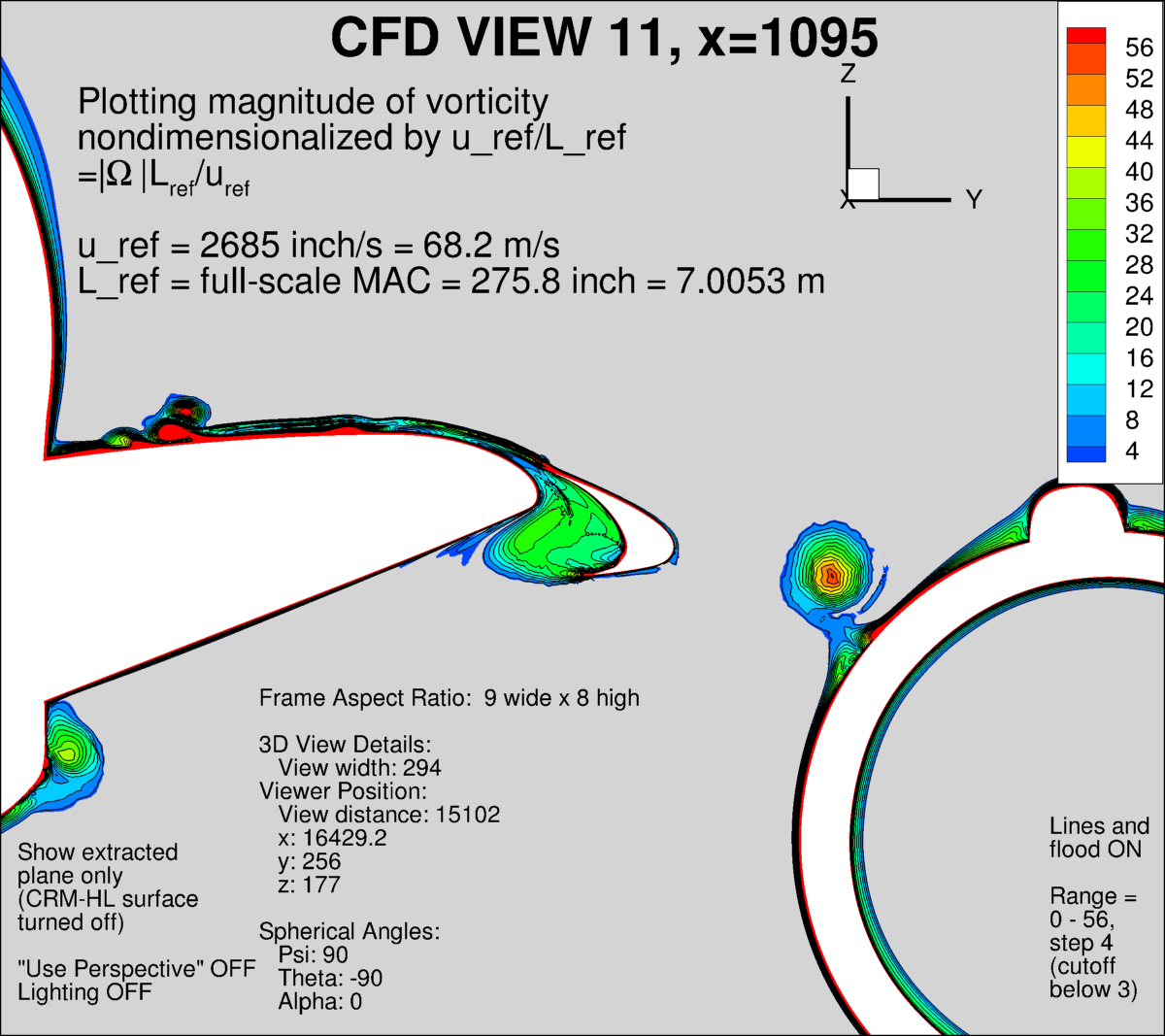
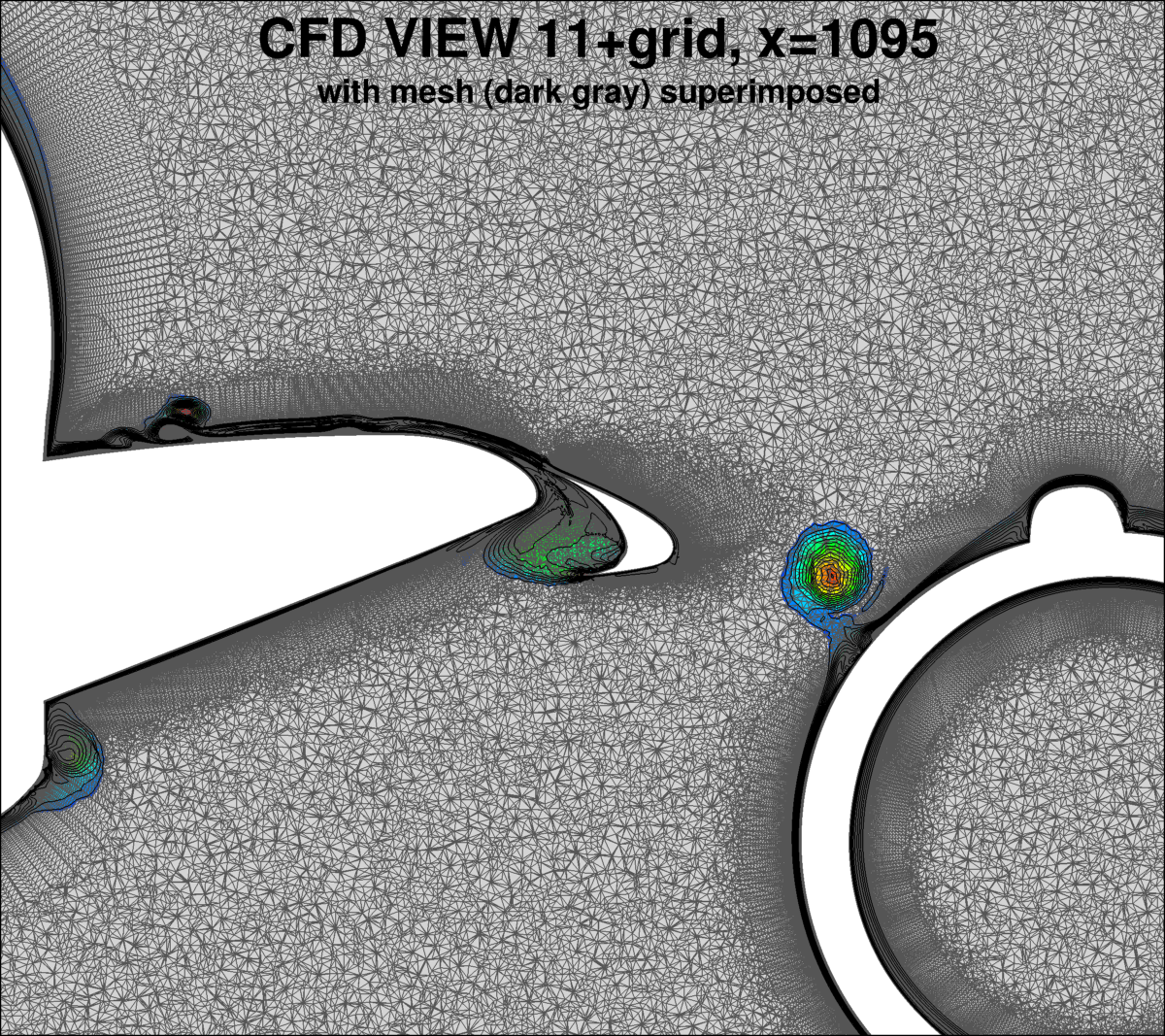


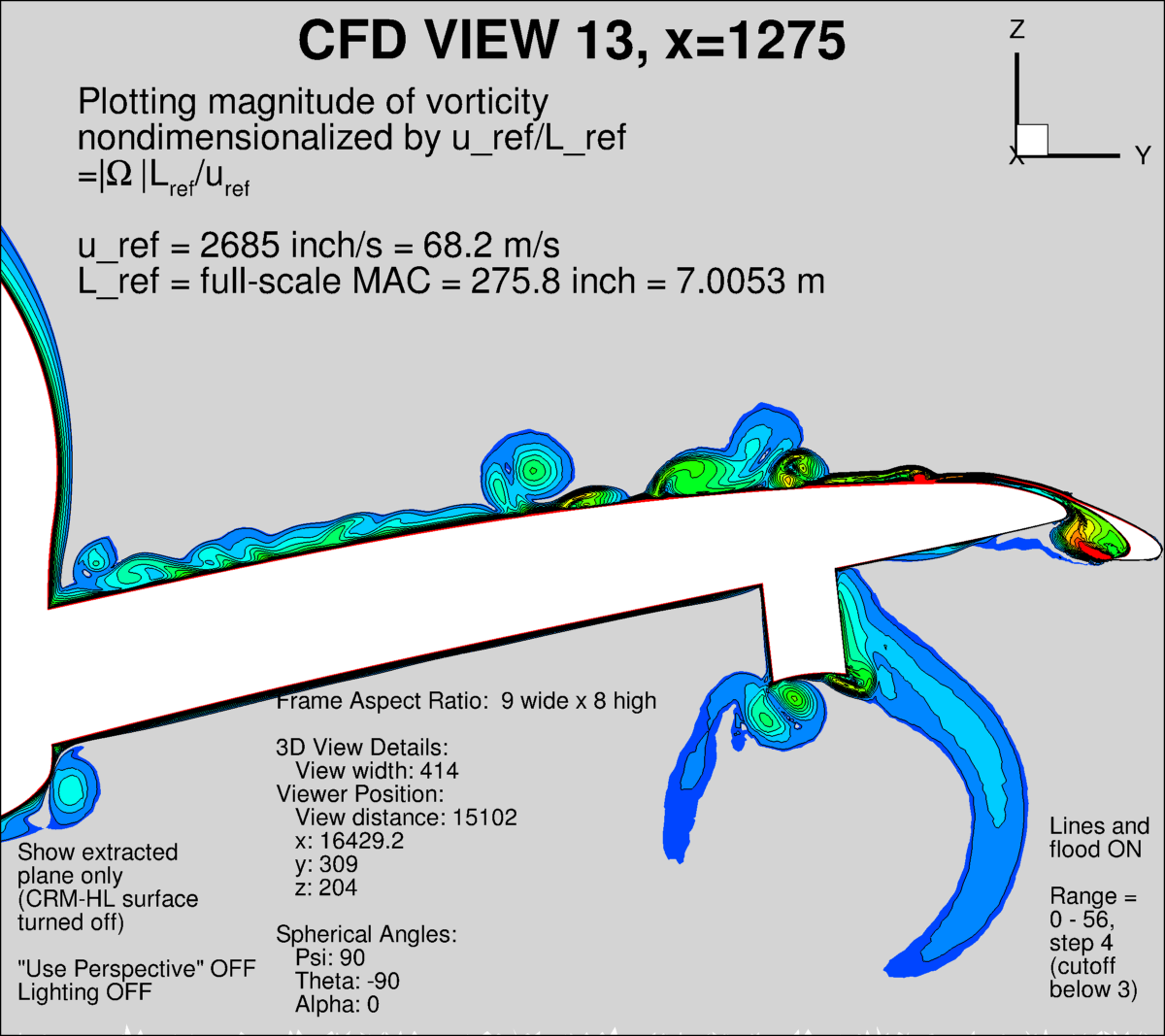

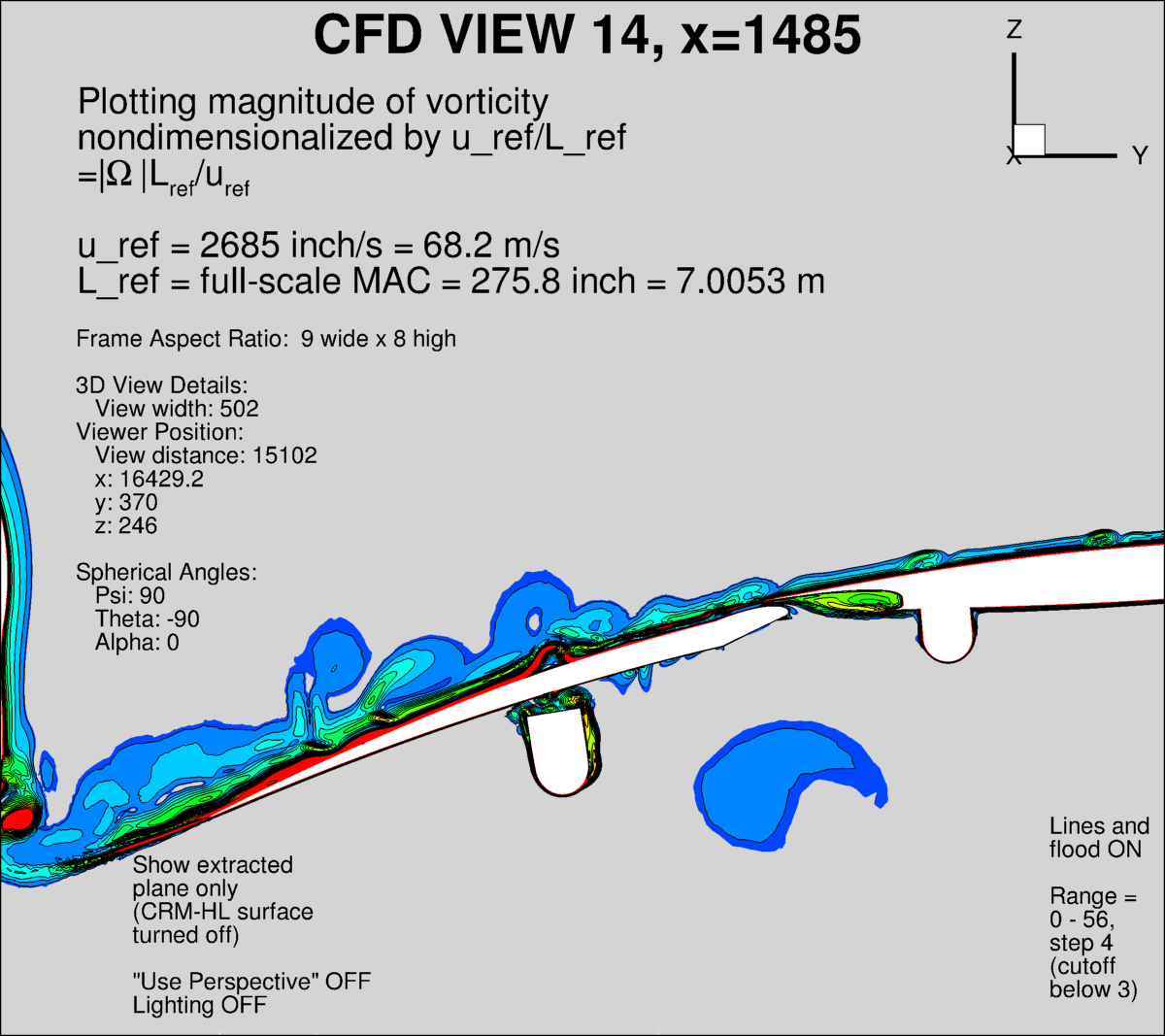
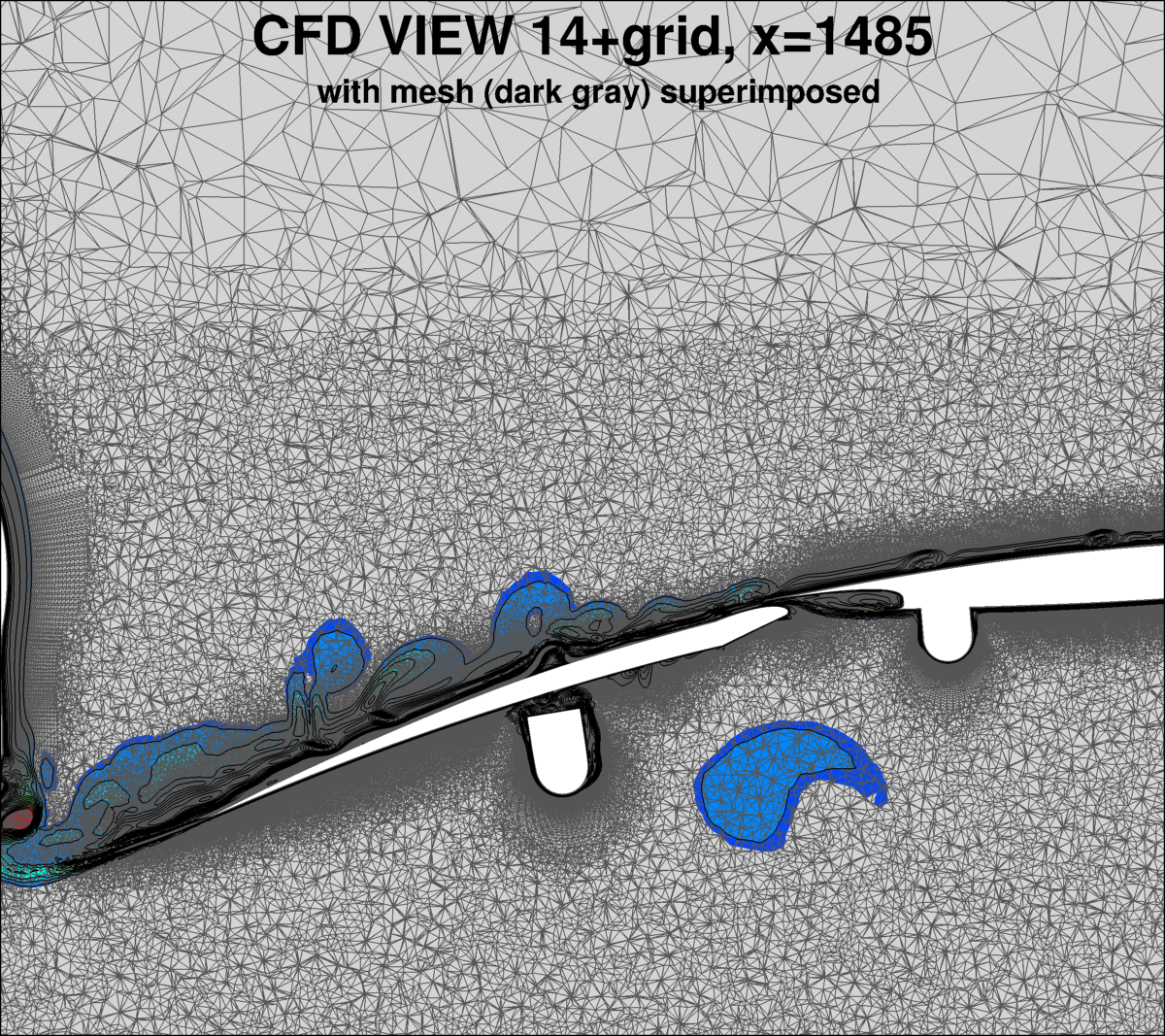

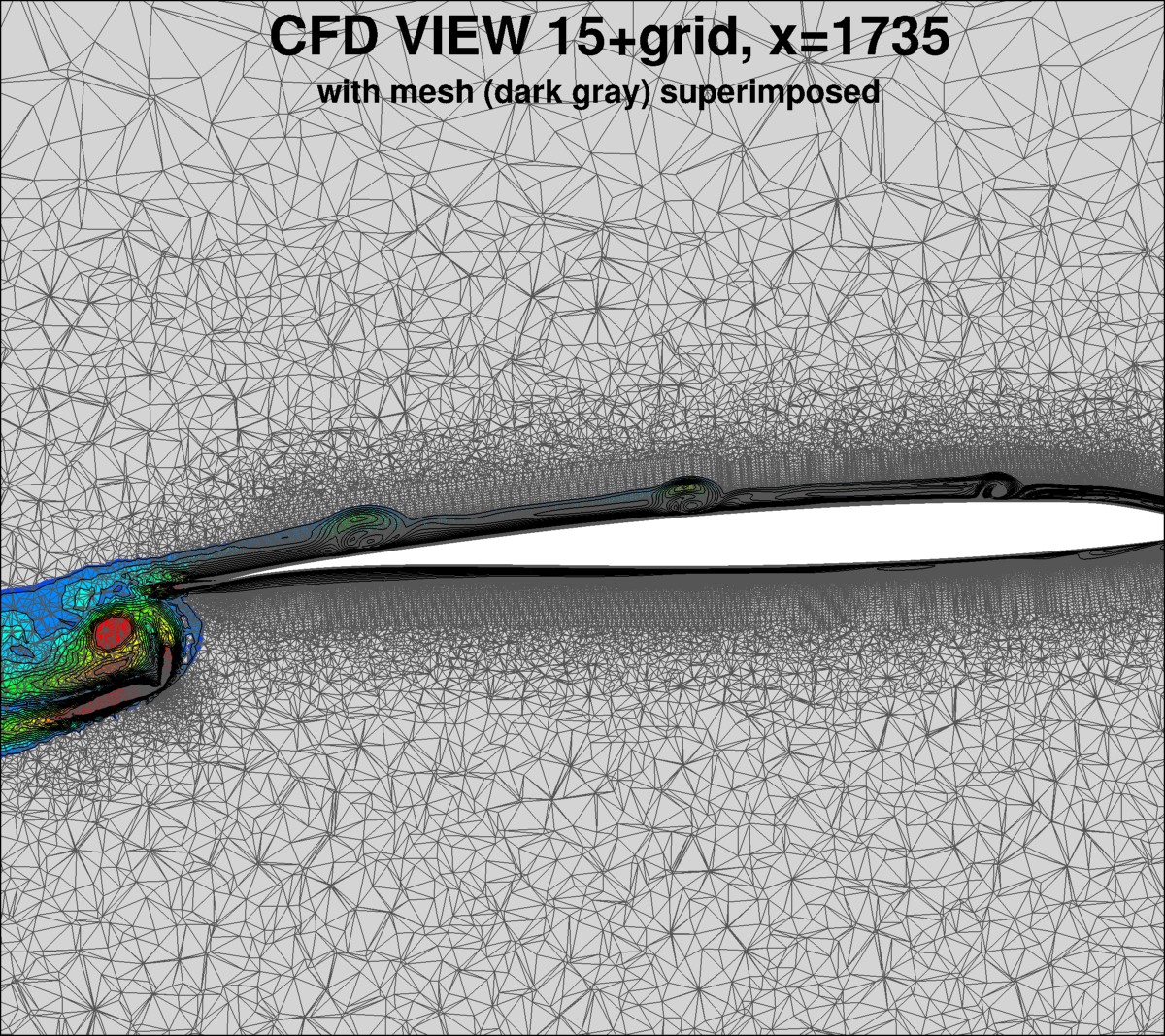
The Tecplot layout files for the above five views are provided here:
XXX_cfdview_11_x1095.lay,
XXX_cfdview_12_x1185.lay,
XXX_cfdview_13_x1275.lay,
XXX_cfdview_14_x1485.lay,
XXX_cfdview_15_x1735.lay.
Note that these files are most likely NOT directly applicable to most participants' data (in particular they assume that the
variable "vort_mag" is already appropriately nondimensionalized); therefore
they should be used for guidance only.
Note that all of the above assumes that your grid is in full-scale inches! If your grid is in different
units, please be sure to translate to full-scale inches prior to submittal. For example, if your grid
is in full-scale meters, then (if you are using Tecplot) execute:
- {x}={x}*39.37
- {y}={y}*39.37
- {z}={z}*39.37
to translate it to full-scale inches prior to proceeding. The above Tecplot macros should then work,
and the CFD views should be relevant.
Return to: High Lift Prediction Workshop Home Page
Recent Significant Site Updates
11/20/2021 - Additional clarification added to Detailed Instructions
09/15/2021 - Vorticity contours changed to have Lref as full-scale MAC (rather than 1 inch)
09/13/2021 - Fixed vorticity definition in CFD view 12-15 pics
08/31/2021 - Updated the Tecplot-Readable Data Submittal Forms to v9
08/26/2021 - Updated the Tecplot-Readable Data Submittal Forms to v8 and added off-body vorticity contours (CFD views 11-15)
05/18/2021 - Updated the Tecplot-Readable Data Submittal Forms to v7
04/21/2021 - Preferred CFD views specified
04/13/2021 - Updated the data submittal forms and provided more detailed instructions
04/01/2021 - Minor change in sectional_cutter Tecplot macro files, including new separate versions for each wing element
03/17/2021 - Added request for surface streamline pictures as part of Data Submittal
02/02/2021 - V3 Data Form Templates posted, including information for velocity profiles and unsteady surface pressures
01/13/2021 - V2 Data Form Templates for Cases 1 and 2 posted, including pressure/skin friction forms; pressure tap cutting plane locations also posted
12/18/2020 - Initial Data Form Templates for Cases 1 and 2 posted
12/11/2020 - Clarifying change made in two of the Verification Study forms - data to be submitted on 3 finest grids
Privacy Act Statement
Accessibility Statement
Responsible NASA Official:
Li Wang
Page Curator:
Li Wang
Last Updated: 01/21/2022
